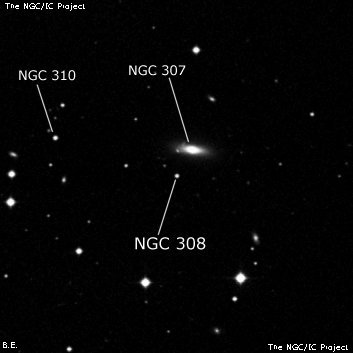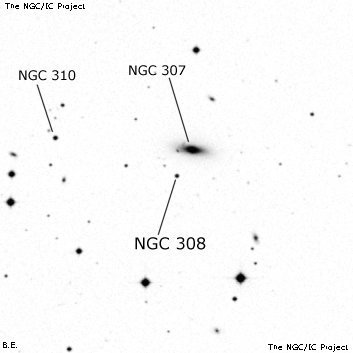NGC/IC Project Restoration Effort
(This is a very very beta version)
NGC308


Basic Information
Location and Magnitude
Right Ascension: 0:56:34.3
Declination: -1:47:1
Constellation: CET
Visual Magnitude:
Historic Information
Discoverer: Ball
Year of discovery: 1866
Discovery aperture: 72.0
Observational
Summary description: vF, eS, 1' sf h 77
Sub-type: *
Corwin's Notes
=====
NGC 308 and NGC 310 are both stars. [All this is from a July 1989 letter to
Malcolm Thomson; it's a bit wordy, but I've saved it like this since it has a
few details in it about my pre-DSS working methods.] Since Lord Rosse
measured the positions of NGC 308 and 310 in relation to NGC 307, I decided to
do the same. Using a comparator with a millimeter scale and an "angle fan"
scale, I measured the distances and position angles of objects surrounding
NGC 307 on the Palomar Sky Survey print. Since the scale of the paper prints
is different in the x and y directions by about 0.9%, the measurements are
liable to be a bit off from what would be measured on a glass plate.
Estimating the center of NGC 307 was also a problem, and the resulting errors
probably swamped the print scale problem. Nevertheless, the measurements are
adequate to unambiguously identify the objects in question.
So, here is a table of the objects identified and measured by Lord Rosse and
myself. I've also included [Malcolm Thomson's] measurement of the galaxy
that the RNGC calls NGC 310.
Object Observer PA Dist Date Notes
(deg) (arcsec)
GC 5126 Ld. R. 147 60 31 Dec 1866 Measure obviously approximate
= N308 Ld. R. 149.7 52 23 Oct 1876 Mean of two measures
= star HC 150+- 52 14 Jul 1989 PA approx
GC 5128 Ld. R. 81 225 31 Dec 1866 "Another neb. susp. near."
= N310 Ld. R. 84.8 239 23 Oct 1876 One measure only
= star HC 84 231 14 Jul 1989
--- HC -- --- 25 Oct 1983 "Both novae are stars."
eF nova Ld. R. ssf 3-4 min 8 Nov 1866 Estimated position
Stars HC (same) (same) 14 Jul 1989 "Only stars here"
Star Ld. R. 199 225 31 Dec 1866
Ld. R. 201.6 240.1 23 Oct 1876 "* 11m. sp [GC] 172"
HC 201 235 14 Jul 1989 On [Thomson's] sketch
Star Ld. R. 0+- 3.25min 23 Oct 1876 "* 11.12m, 3.25min exactly
north of [GC] 172."
HC 357 170 14 Jul 1989 On [Thomson's] sketch
Gal B HC 91 303 14 Jul 1989 On [Thomson's] sketch
MT 90+- 4min Jun 1989?
Gal C HC 215 185 14 Jul 1989 On [Thomson's] sketch
Gal "D" HC 338 92 14 Jul 1989 On [Thomson's] sketch, unlabeled
That's all the observations there are, aside from the modern work on NGC 307
(photometry, spectroscopy, etc.). Dreyer's NGC positions (and the offsets
from NGC 307) are derived from Lord Rosse's measurements, so don't give us any
new data. As you can see, my measurements agree (within the errors, a few arc
seconds, and about 2 deg in PA) exactly with Lord Rosse's, and pinpoint the
two stars as the "nebulae" that he found. Adding to my conviction that this
must be correct is the fact that the galaxies C and D are approximately the
same brightness as B, yet Lord Rosse mentions neither, in spite of the fact
that he noticed the star further to the north of D and NGC 307.
I also suspect that [Thomson] is correct that the "...2st., 13.14 m. sf"
Lord Rosse's "...similar object, more stellar" seen during the 1876
observation are probably the two that [Thomson] mentioned, but that he (LdR)
again missed the real nebula (B). There is a faint possibility that Lord
Rosse actually saw the nucleus of B and just one of the sf stars, but this
would need confirmation. I think he also may have glimpsed the faint star
very close sff NGC 307 on 8 Nov 1866: "...on the p side is either a * close
or some other appearance different to the f. side." However, since there is
no star on the western side that I can see on the print, it is only the
"some other appearance to the f. side" that offers evidence of this, so I
wouldn't want to push this.
In sum, I have no choice but to stand by my original conclusion that both NGC
308 and 310 are stars mistaken for nebulae. The agreement in the distances
and position angles from NGC 307 allows no other conclusion.
-----
In March 2016, I received from Yann Pothier a list of "novae" in LdR's
monograph that included a galaxy near NGC 307. That galaxy is the one called
"eF nova" in the list above. Yann suggested that the object is actually the
faint galaxy south-southwest of NGC 307. Following up on this, I noticed what
at first I took to be a superposed star on the eastern side of the bright
galaxy -- above I quote the observation from 8 Nov 1866 (actually by R.S.
Ball, LdR's observer at the time) noting a star on the west side of the
galaxy. Since Ball was also responsible for the discovery of the "eF nova"
three or four arcminutes south-southeast, I'm going to suggest that he had his
directions reversed. So, if the superposed object -- actually a background
galaxy -- that he saw is on the eastern side of NGC 307, then the "eF nova" is
probably three or four arcminutes south-southwest. Indeed it is. See the
"notngc" files for a bit more.



